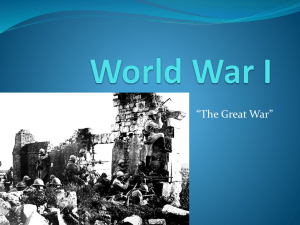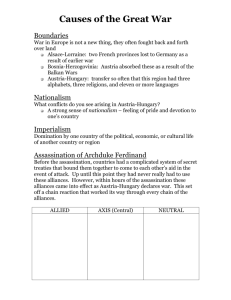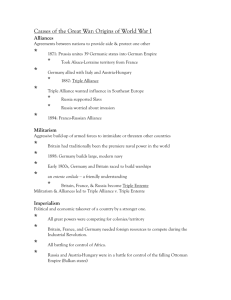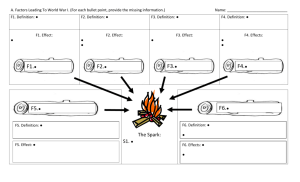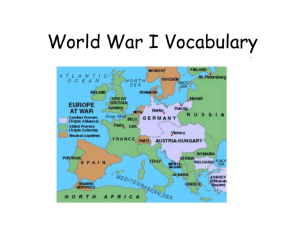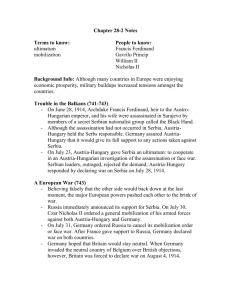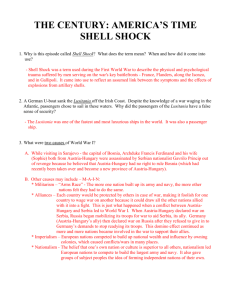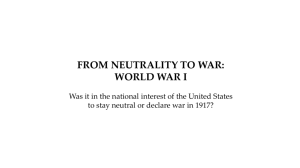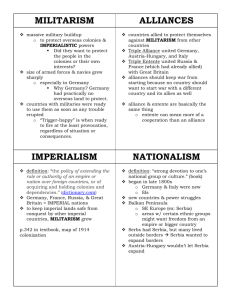File - John Allen's Student Impact Portfolio
advertisement
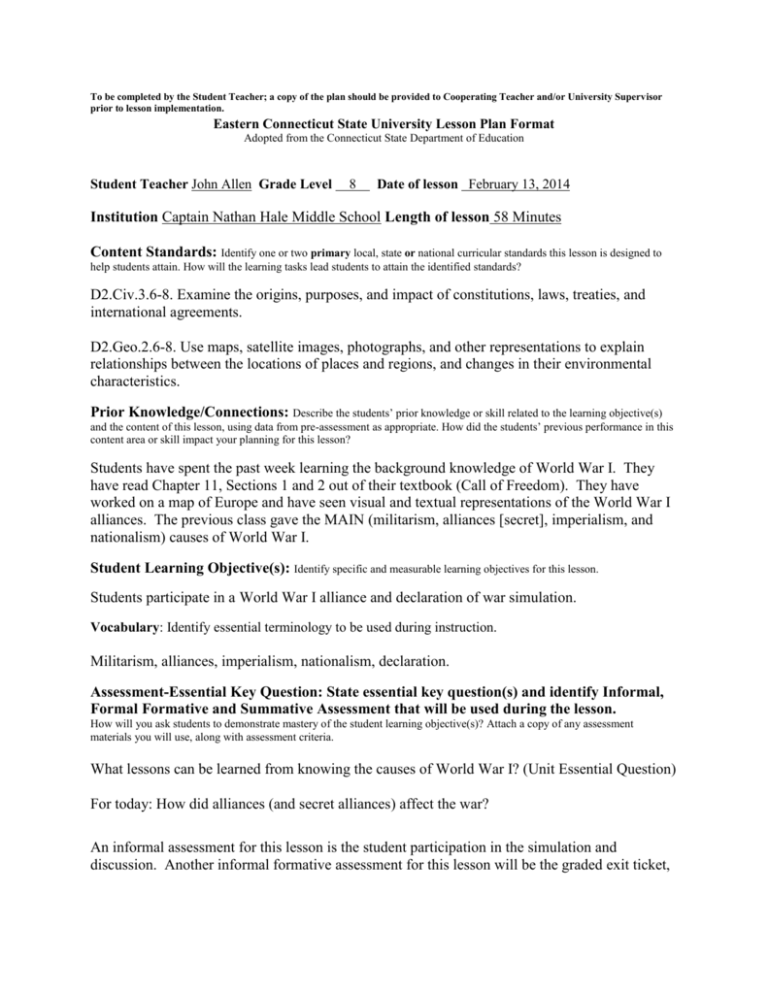
To be completed by the Student Teacher; a copy of the plan should be provided to Cooperating Teacher and/or University Supervisor prior to lesson implementation. Eastern Connecticut State University Lesson Plan Format Adopted from the Connecticut State Department of Education Student Teacher John Allen Grade Level 8 Date of lesson February 13, 2014 Institution Captain Nathan Hale Middle School Length of lesson 58 Minutes Content Standards: Identify one or two primary local, state or national curricular standards this lesson is designed to help students attain. How will the learning tasks lead students to attain the identified standards? D2.Civ.3.6-8. Examine the origins, purposes, and impact of constitutions, laws, treaties, and international agreements. D2.Geo.2.6-8. Use maps, satellite images, photographs, and other representations to explain relationships between the locations of places and regions, and changes in their environmental characteristics. Prior Knowledge/Connections: Describe the students’ prior knowledge or skill related to the learning objective(s) and the content of this lesson, using data from pre-assessment as appropriate. How did the students’ previous performance in this content area or skill impact your planning for this lesson? Students have spent the past week learning the background knowledge of World War I. They have read Chapter 11, Sections 1 and 2 out of their textbook (Call of Freedom). They have worked on a map of Europe and have seen visual and textual representations of the World War I alliances. The previous class gave the MAIN (militarism, alliances [secret], imperialism, and nationalism) causes of World War I. Student Learning Objective(s): Identify specific and measurable learning objectives for this lesson. Students participate in a World War I alliance and declaration of war simulation. Vocabulary: Identify essential terminology to be used during instruction. Militarism, alliances, imperialism, nationalism, declaration. Assessment-Essential Key Question: State essential key question(s) and identify Informal, Formal Formative and Summative Assessment that will be used during the lesson. How will you ask students to demonstrate mastery of the student learning objective(s)? Attach a copy of any assessment materials you will use, along with assessment criteria. What lessons can be learned from knowing the causes of World War I? (Unit Essential Question) For today: How did alliances (and secret alliances) affect the war? An informal assessment for this lesson is the student participation in the simulation and discussion. Another informal formative assessment for this lesson will be the graded exit ticket, that will be turned in again as part of the summative assessment (the World War I portfolio) for the unit. Materials/Resources: List the materials you will use in each learning activity. Yarn (three different colors, one color per alliance and one color for war declarations), World War I simulation script (for the teacher), paper, pen/pencil. Technological resources: List the technology resources that you will use in this lesson. Camera for photos of the simulation (if Mrs. Maxwell Permits). Learning Activities: Identify the instructional and strategies and instructional grouping (whole class, small groups, pairs, individuals) you will use in each lesson segment and approximate time frames for each. Instructional Strategies: Simulation-30 to 40 Minutes Discussion-10 to 15 Minutes Assigning Exit Ticket-5 Minutes Grouping Strategies: Whole Class Grouping (In the shape of Europe) Individual (For exit ticket only) Initiation: Briefly describe how you will initiate the lesson. (Set expectations for learning; articulate to learners what they will be doing and learning in this lesson, how they will demonstrate learning, and why this is important) Students will be given a country card (index card with a country’s name on it). Then they will go to their corresponding desk and sit down. The desks will be positioned like places in the world-Countries within Europe will be grouped together, and those outside of Europe (Iceland, the United States, Australia, and New Zealand) will be outside of the main group. Lesson Procedures: Describe how you will develop the lesson, what you will do to model or guide practice, and the learning activities students will be engaged in order to gain the key knowledge and skills identified in the student learning objective(s). After students find their seat, they will be instructed on what the class will be about. The students will be asked to briefly explain each of the causes once more. After that I will start the simulation. The simulation will run by a script that I have prepared. For each connection between countries, a piece of yarn will represent that they are “tied together.” One color of yarn will represent a “tie” to another country within an alliance. The Triple Alliance and the Triple Entente will have two different colors. The first half of the simulation is the back story to the war, all of the pre-World War I alliances will be revealed, with a piece of yarn for each connection. After we reach World War I, we will run the simulation off of a chronological list of declarations of war. When a country of one alliance declares war with a country of the other alliance, they will be connected by a third color of yarn. The idea is that by the end of the simulation, the students will understand the magnitude of this WORLD War. The yarn will look like a mangled mess, and that is intentional. I will ask students to clean up the yarn and return to their seats. I will then run a class discussion about what students saw in the simulation. The discussion will be finished with an individual exit ticket that will ask students to explain what they saw in the simulation that day. Closure: Briefly describe how you will close the lesson and help students understand the purpose of the lesson. (Interact with learners to elicit evidence of student understanding of purpose(s) for learning and mastery of objectives). To be completed by the Student Teacher; a copy of the plan should be provided to Cooperating Teacher and/or University Supervisor prior to lesson implementation. The discussion will be finished with an individual exit ticket that will ask students to explain what they saw in the simulation that day. These exit tickets will be handed in and graded. Intervention: Describe intervention strategies used for students who require accommodations to their instruction. This lesson gives all students a chance to visually see how alliances worked during the First World War. Not only that, but every student will be given a country and be involved in the simulation. I will be turning to students to try to explain the simulation during the discussion. Having them explain the simulation will help them learn it. Students with language barriers (ELL students) will be able to see the concepts and hear them as well. Enrichment: Describe strategies used for students who benefit from unique challenges in the classroom curriculum. Students who require a challenge will be assigned countries that played a larger role. Active participation in the simulation will engage and benefit all students. Reflection: Identify areas of strength and areas for improvement. Notes from the pre-conference: Name:_______________________________ Date:_____________________ Simulation Response What did this simulation teach you about the First World War? What part of the simulation did you like best? _____________________________________________________________________________________ _____________________________________________________________________________________ _____________________________________________________________________________________ _____________________________________________________________________________________ _____________________________________________________________________________________ _____________________________________________________________________________________ _____________________________________________________________________________________ _____________________________________________________________________________________ _____________________________________________________________________________________ _____________________________________________________________________________________ _____________________________________________________________________________________ _____________________________________________________________________________________ _____________________________________________________________________________________ Mrs. Maxwell/Mr. Allen World War I Secret Alliance Simulation Script Background Knowledge Britain agreed to protect Belgium’s Neutrality in the Treaty of London in 1839. Germany, after the Franco-Prussian War, created the Dual Alliance Treaty in 1879 with AustriaHungary (one monarchy, two countries) which made official Germany’s intention of protecting Austria-Hungary and vice versa. It is important to note that part of the reason for this alliance is that Germany felt paranoid of both France and Russia, and would need more military support if war came. Since Germany’s formation, it had a strong emphasis on its military and navy. As a new country, it needed to be able to protect itself if war came. There were many states in Germany, and this was one of the ways that it created a national identity. Lastly, after the Franco-Prussian War, Germany had obtained Alsace-Lorraine in France, and France was VERY angry about it. Seeing that Germany and Austria-Hungary were close, France formed an alliance with Russia in 1892. Triple Entente (agreement): Not a super formal alliance, but resolved international issues with each other. This resolved the potential reasons why each country might face each other in a future war. England with France 1904 England with Russia 1907 Italy was in a Triple Alliance with both Germany and Austria-Hungary, but would later align with the Entente countries during World War I. THE SPARK 1908 Austria-Hungary Annexes Bosnia & Herzegovina. Serbia does not like this. o Serbia racially and culturally related a third of the people living in Bosnia & Herzegovina. Ex/Same Language, Eastern Orthodox religion, etc. o Serbia upset and angry with Austria-Hungary for splitting their people away from each other. This would be similar to Canada taking New Hampshire, Vermont, and Maine. Connecticut, Massachusetts, and Rhode Island would be angry. o Serbian Nationalists encouraged people in the southern Slovak states (now a part of the Austrian-Hungarian Empire) to revolt and liberate themselves. This created tension between Austria-Hungary and Serbia. Gavrilo Princip, one in a team of six Serbian nationalists, was the Serbian nationalist who shot Franz Ferdinand (the heir to the monarchy of AustriaHungary) and his wife Sophie on June 28, 1914. In response, Austria-Hungary issues an ultimatum to Serbia. o Basically, the ultimatum stated that Serbian needed to renounce the event or Austria-Hungary would take action. Serbia basically said that they would look into it. Austria-Hungary was not impressed with the investigation. o Austria-Hungary wanted to punish Serbia for this event, and for the nationalists trying to start revolutions in the southern Slovak states. (Croatia-Slovenia, Dalmatia, and Bosnia & Herzegovina) One month after the assassination, Austria- Hungary declares war on Serbia on July 28, 1914. GIANT SUSPENSEFUL PAUSE ~~~~~~~~~~~~~~~~~~~~~~~~ The Domino Effect In response to its ally being under attack, Russia mobilizes its army to help defend Serbia, something that Austria-Hungary did not consider as greatly as they should have. Russia-HUGE ARMY. August 1, 1914-In response to Russia mobilizing its army, Germany defends AustriaHungary and declares war on Russia. August 3, 1914-Knowing that Russia is aligned with France, Germany also declares war on France. August 4, 1914-Germany invades Belgium and quickly gets to the French border and begins to invade. August 4, 1914-England, who is aligned with Belgium (and France) then declares war on Germany. o This pulls in their empire into the war: Canada, New Zealand, and Australia all join the war. France declares war on Austria-Hungary on August 12, 1914. World War I Ensues. Iceland, Switzerland, Spain stayed neutral. August 1914 (continued) August 5, 1914-Montenegro declares war on Austria-Hungary. August 6, 1914-Austria-Hungary declares war on Russia August 6, 1914-Serbia declares war on Germany. August 8, 1914-Montenegro declares war on Germany. August 12, 1914-France on Austria-Hungary. November 1914 November 2, 1914-Serbia on the Ottoman Empire. November 5, 1914-France on the Ottoman Empire. November 5, 1914-England on the Ottoman Empire. May 1915 May 23, 1915-Italy on Austria-Hungary. August 1915 August 21, 1915-Italy on the Ottoman Empire. August 28, 1915-Italy on Germany. October 1915 October 14, 1915-Bulgaria on Serbia. October 15, 1915-Montenegro on Bulgaria. October 15, 1915-England on Bulgaria. October 16, 1915-France on Bulgaria. October 19, 1915-Russia on Bulgaria. October 19, 1915-Italy on Bulgaria. August 1916 August 27, 1916-Romania on Austria-Hungary. August 30, 1916-The Ottoman Empire on Romania. September 1916 September 1, 1916-Bulgaria on Romania. April 1917 April 6, 1917-United States of America enters the War and declares war on Germany. June 1917 June 27, 1917-Greece declares war on Austria-Hungary, Bulgaria, Germany, and Turkey. December 1917 December 7, 1917-United States of America on Austria-Hungary.
